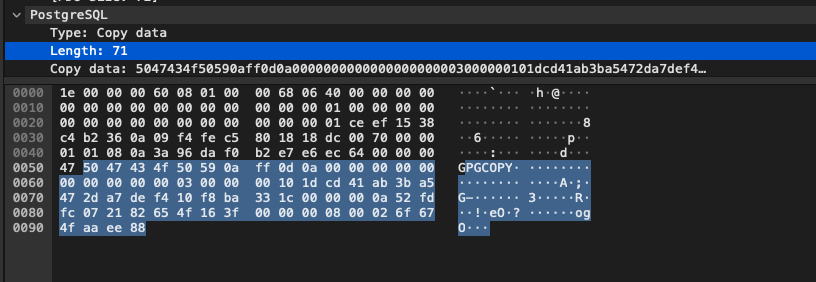
You would see the COPY that's trying to insert data, always being busy with that type of wait event versus other wait events. What you would see is in your pg_stat_activity. This is what would currently be triggered if you're running into this being a bottleneck. If you want to know whether there is a chance that you will benefit from this once Postgres 16 comes out: when you're doing these types of bulk loads with COPY watch out for the wait event of wait event type "lock" and then the lock wait event "extend". In some cases where you're seeing that bottleneck on that relation extension lock, you will see a significant improvement in the performance with Postgres 16 Beta 1. The second commit then makes use of that new infrastructure to be able to extend these tables more efficiently.
#Postgres copy code#
There are now better code paths to have a bulk extension of multiple pages that need to be created. Previously, that was, in a sense, a rather simplistic code path. "Relation extension" means you're increasing the size of the table on disk. First of all, new infrastructure for extending relations in a particular way. Now, there are two main aspects of how that is done.

New infrastructure for extending relations Today, when you're adding data into a table and you're creating new pages in the table, each time that Postgres is adding a new page it has to hold this relation extension lock. The refactoring work that Andres worked on in Postgres 16 relates to reducing the time that relation extension lock is held. As Andres describes in his mailing list thread, it’s really way too much work whilst holding that lock. And there's a lot of work that used to be done whilst holding that lock.
#Postgres copy Patch#
However, this particular patch here tried to resolve one of the particular bottlenecks that show even today and that don't actually need async I/O, they just need a better way of handling what's called relation extension locks. Improving relation extension locks in Postgres 16 Beta 1 And asynchronous I/O is not going to make it in Postgres 16, there were a couple of patches that relate to it like this one, but Postgres 17 is going to be the first release where there is actually going to be interesting, I would say, async I/O benefits. The background on this is a longer mailing list thread, but the context here is that Andres and team have been working on asynchronous I/O in Postgres. This is a patch that Andres Freund committed a couple of weeks ago, shortly before the feature freeze. This means that this has to do with copying data into a table and the file on disk becoming larger as you're copying data in. In the release notes, this is related to the item that says " allow more efficient addition of heap and index pages". Now, what stands behind that sentence? When you look at the release notes this is a bit more hidden. This doesn't always apply, but in some cases you will see your COPY being much faster in Postgres 16. I wanted to spend today talking a little bit more about one of the features I haven't previously looked at closer, which is mentioned in the release notes as “improving the performance of the concurrent bulk loading of data using COPY up to 300%”. Speeding up Postgres performance in PG16 Beta 1 But, if you're curious about a summary you can look at the release announcement here, or you can also look at the release notes in the Postgres documentation. Looking at what is included in Postgres 16, we talked about quite a few features already in previous 5mins of Postgres episodes, I’ll link them at the end of this article. If you want to test out Postgres 16, you can follow the instructions on the Postgres website, or for some providers like Amazon RDS, they also offer Postgres 16 Beta 1 in their preview environments, so you can try it out that way. So it's still a couple of months until then, but this is really the time now to give feedback to the community and to the patch authors so that they can incorporate your feedback ahead of the release. Note that Postgres 16 will probably come out officially in September or October. This means this is a good time to start testing Postgres 16 to see if the new features contain any bugs, or if you feel that there's something, for example, not well written in the documentation that could use clarification. Last week, the first beta release of Postgres 16 was officially announced. Let's jump in! Getting started with Postgres 16 Beta 1 What we have discussed in this episode of 5mins of Postgres
#Postgres copy how to#
How to find out if you can benefit from this New infrastructure for extending relations.



 0 kommentar(er)
0 kommentar(er)
